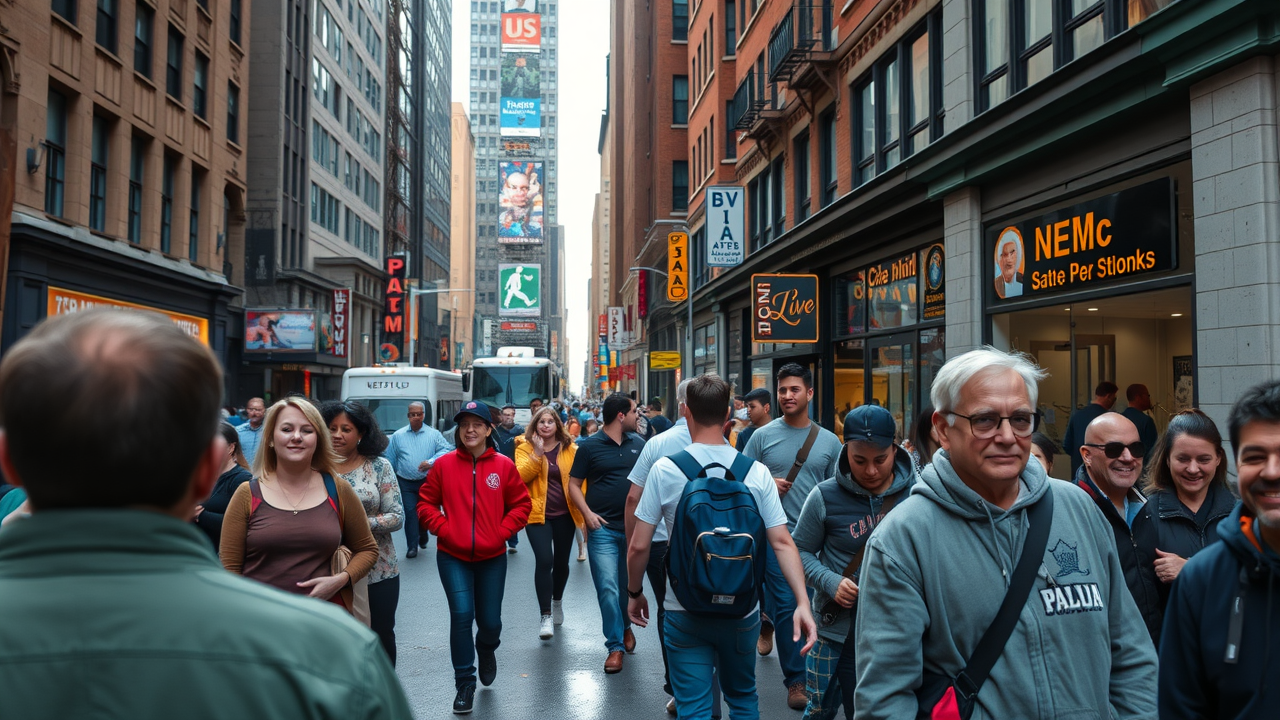
Did you know Legionnaires' disease cases in New York City have climbed by more than 50% in the last decade, hitting neighborhoods like Central Harlem the hardest? This rapid rise in a disease connected to everyday elements of city living—like cooling towers and large air conditioning systems—has residents and health officials on high alert.
In this article, we’ll explore the dramatic surge in cases, examine the city's response, and reflect on what these outbreaks mean for public health and confidence in city management. Could your daily environment put you at higher risk, and are we doing enough to stop it? Read on to discover the urgent lessons within this disease outbreak and what every New York City resident should know to stay safe.

A Startling Rise: Legionnaires' Disease Outbreaks in New York City Make Headlines
Legionnaires' disease has become a growing concern in York City, with frequent reports of disease outbreaks making regular headlines. This situation presses both residents and city health officials to question the safety of seemingly innocuous elements like public water systems and cooling towers. With cases surging mainly in densely populated neighborhoods, the risks are more than statistical—they’re personal.
For example, the Central Harlem district recently witnessed a dramatic spike in infections, serving as a wake-up call for building owners, city administrators, and community members alike. These outbreaks often follow patterns linked to warm water systems and large air conditioning units—everyday infrastructure that's hard to avoid in urban environments. The Centers for Disease Control and Prevention (CDC) and the local health department are collaborating to pinpoint sources and implement rapid interventions.
The Stark Reality: Recent Data on Legionnaires' Disease in Central Harlem
Data from the city health department reveals just how severe the problem has become:
"Cases of Legionnaires' disease have surged by over 50% in the last decade in New York City, according to health officials." – City Health Department Spokesperson
With Central Harlem currently reporting 90 cases in a single recent incident, these numbers highlight the vulnerability of specific zip codes and communities. Residents in high-risk areas, especially those with underlying health conditions like chronic lung disease or weakened immune systems, face an elevated threat.
Experts such as Michelle Morse, a well-known health official, underscore the need for targeted outreach and easier access to health care providers for communities experiencing repeated outbreaks. These patterns illustrate a disturbing connection between infrastructural neglect and public health risks that demand sustained attention.
While Legionnaires' disease is currently in the spotlight, it's important to recognize that other public health threats—like extreme heat—can also strain city infrastructure and disproportionately impact vulnerable communities. For a closer look at how cities prepare for and respond to environmental health challenges, explore these strategies for managing record heatwaves and their effects on public well-being in preparing for another summer of record heat.

Understanding the Cooling Tower Connection: How Disease Outbreaks Originate
The role of cooling towers in spreading legionnaires' disease cannot be overstated. These structures, often perched atop residential and commercial buildings, recirculate large volumes of water—a necessary function for temperature regulation in sprawling urban environments like York City. However, when cooling towers are inadequately maintained or left unchecked, they become prime breeding grounds for Legionella bacteria, the culprit behind this dangerous type of pneumonia.
Environmental factors play a significant part. High temperatures during summer months lead to the rapid growth of bacteria within stagnant or poorly disinfected water. Large complexes with extensive air and water handling systems—such as hospitals, schools, and office towers—are especially vulnerable. Health officials continually remind building owners that lack of regular inspection and subpar sanitation can quickly escalate into full-blown disease outbreaks. The Centers for Disease Control and Prevention recommends regular maintenance as a frontline defense.
Inside York City Health Department's Response to the Legionnaires' Disease Cluster
When news of a disease outbreak surfaces in York City, the health department launches a coordinated campaign involving health officials, building owners, and public communications teams. Immediate goals include identifying outbreak sources, containing the disease, and reassuring the public with transparent updates. City health experts have developed a playbook involving emergency inspections, rapid water sampling, and direct outreach to potentially affected communities.
Municipal agencies, including the Centers for Disease Control and Prevention, provide real-time support through laboratory analysis and outbreak modeling. The ultimate measure of success, though, lies in gaining and maintaining public trust, especially among New Yorkers justifiably wary after multiple recent incidents. Transparent reporting of locations, case numbers, and outcomes has become a cornerstone of the city’s response.
Health Officials on Alert: Coordinated Efforts Against Legionnaires' Disease
As health officials maintain heightened vigilance, teamwork is essential. Teams of inspectors, scientists, and medical doctors converge on identified hotspots, such as Central Harlem, to collect water samples, examine building schematics, and alert the broader health care system. The urgency stems from the need to act before the Legionella bacteria can infect vulnerable populations or spread to new zip codes.
These rapid-response efforts in York City draw on lessons from earlier disease outbreak control campaigns, adapting them to the specific quirks of cooling tower infrastructure and local epidemiology. Health department hotlines and neighborhood outreach events help ensure everyone, including those with chronic lung conditions, receives timely care and follow-up. The message: early detection and collective action save lives.

Transparency and Trust: Public Communication During Disease Outbreaks
Transparent, accurate communication is critical during any public health emergency. The York City health department issues daily briefings, push notifications, and community updates that clarify risks, symptoms, and steps for residents to take. During the most recent Legionnaires' disease cluster, these efforts went beyond mere press releases; local clinics received prevention guidance and multilingual alerts reached those most at risk.
Surveys show residents are more likely to comply with advisories and treatment protocols when they believe health officials are honest and accessible. Public forums—whether in-person or televised—feature leading experts like the health commissioner, empowering individuals to ask questions and voice concerns. This two-way dialogue fosters the kind of trust upon which successful disease management depends.
Public Health Risks: What the Legionnaires' Disease Cluster Means for New York City
The public health implications of a legionnaires' disease outbreak extend well beyond the individuals who contract the illness. Elevated anxiety ripples through neighborhoods, especially those like Central Harlem and the Bronx, where clusters have hit hardest. City residents with higher risk profiles—such as the elderly, smokers, and people with existing chronic lung conditions—face more severe consequences and hospitalizations.
For every headline, there are dozens of families worrying about symptoms like persistent cough, fever, and shortness of breath. The cluster effect creates a shared sense of vulnerability and, sometimes, public frustration over perceived government inaction. Yet, such experiences also build resilience and foster grassroots outreach, encouraging New Yorkers to take an active interest in public health policy.

Health Official Warnings and Community Reactions
Health officials continuously issue warnings urging anyone who develops flu-like symptoms to seek help from a health care provider, especially those living or working close to impacted cooling towers. The guidance is clear: Legionnaires' disease is not spread from person to person but through the inhalation of water droplets containing Legionella bacteria. Despite repeated messaging, some in the community worry about delays in official alerts and call for more proactive reporting from city agencies.
In highly affected neighborhoods, community forums bring together residents, city officials, and building owners to exchange firsthand accounts and demand better oversight. People often compare notes about symptoms and share resources about where to find reliable treatment, including antibiotics recommended by the Centers for Disease Control. These gatherings become a proving ground for rebuilding the fractured trust that a disease outbreak can cause.
Comparisons with Past Disease Outbreaks in York City
Legionnaires' disease is far from the only public health scare New York City has faced in recent years. Residents recall earlier incidents, from measles clusters to the COVID-19 pandemic, which also stressed city health systems and highlighted gaps in disease control and prevention. Like those outbreaks, Legionnaires' disease control involves identifying outbreaks early, supporting vulnerable zip codes, and launching aggressive municipal responses.
Comparing data, some see improvements in speed and transparency, while others argue the root causes—aging infrastructure and uneven access to quality health care—persist. The question remains: are city and state agencies adequately learning from each crisis? By examining how the response to past incidents informed present-day protocols, we highlight the ongoing need for adaptive health leadership at every level.
Personal Reflection: Are We Doing Enough to Prevent Legionnaires' Disease?
"Every disease outbreak reveals gaps not only in city infrastructure, but also in our collective vigilance and trust in municipal processes."
Witnessing the recurring pattern of outbreaks in neighborhoods like Central Harlem, one can't help but wonder if policy, infrastructure, and public awareness are keeping pace with the challenge. Despite efforts to tighten cooling tower regulations, some building owners cut corners or fail to report problems, while economic disparities mean some zip codes remain at higher risk. When I see a neighbor coughing or watch concerned parents speak at community forums, the reality hits harder.
It’s not enough for the health department to react to each disease outbreak; we must all advocate for more regular inspection, transparent public data, and better education on the early signals of illness. Empowering residents to speak up, demand better, and hold city agencies to account may be our best defense for future challenges.

Lessons Learned and Looking Ahead: Strengthening York City Health Initiatives
Every crisis contains lessons—both practical and cultural. The Legionnaires' disease cluster has already led to increased scrutiny of cooling tower maintenance and greater public investment in rapid outbreak response. City and state leaders are focusing on regulatory enforcement, investment in technology, and education campaigns that inform New Yorkers about the warning signs and prevention strategies for the disease.
Only through combined action—across agencies, communities, and individual households—can York City minimize the chances of another major outbreak. Forward-thinking initiatives such as mobile health alerts, stricter penalties for building violations, and funding for disease control research are critical next steps.
Frequently Asked Questions on Legionnaires' Disease in York City
What is Legionnaires' disease and how is it contracted?

Legionnaires' disease is a type of pneumonia caused by Legionella bacteria and is a serious health concern in York City. It is most often contracted by breathing in tiny water droplets or mist (aerosolized water) that come from sources like cooling towers, large air conditioning systems, or hot water tanks. It cannot be spread from person to person.
Common symptoms include cough, fever, muscle aches, and shortness of breath. According to the Centers for Disease Control and Prevention, the illness is typically treated with antibiotics, and individuals with higher risk profiles—such as the elderly or those with chronic lung conditions—should seek prompt care.
How does the health department investigate a Legionnaires' Disease outbreak?
The York City health department’s investigation starts by reviewing recent disease outbreak cases and confirming diagnoses through laboratory testing. Health officials then inspect suspected water systems in neighborhoods or buildings linked to the outbreak—including cooling towers and hot water tanks.
Environmental samples are collected and analyzed for the presence of Legionella bacteria. Efforts include notifying residents, coordinating with the CDC, and advising affected people to consult a health care provider if they feel ill. Transparency and accuracy in reporting help build trust and allow the community to take protective actions quickly.
Are certain neighborhoods more at risk for Legionnaires' Disease in York City?
Yes, the risk of Legionnaires' disease outbreaks in York City varies by neighborhood, often influenced by aging infrastructure, frequency of cooling tower inspections, and community health resources. Areas such as Central Harlem, the Bronx, and southern Queens have experienced repeat outbreaks. Residents in densely populated, lower-income, or older parts of the city—where regular inspection and maintenance may lapse—face a higher risk. Monitoring local health alerts and staying informed through city agencies is key for these communities.
Critical Reflection: The Role of City Health Leadership in Disease Outbreak Management
"Public health is not just about resources, but also about decisive leadership and proactive communication."
Management of disease outbreaks requires not only medical expertise but a willingness to make bold, sometimes unpopular decisions for the common good. Strong health commissioners and city leaders who are visible, accessible, and open to public input drive positive outcomes—even under stress.
The ability to quickly deploy resources, inform the public, and collaborate with the Centers for Disease Control distinguishes effective leadership. Lessons from Legionnaires' disease management in New York City can inspire similar approaches to other public health challenges.
Ultimately, the city’s health leadership must be evaluated not just by the speed of their response, but by their sustained commitment to community engagement, justice, and innovation. Ongoing education for residents, investment in technology, and consistent enforcement of regulations all reflect a city that values every life equally.

Key Takeaways for City Residents about Legionnaires' Disease
Stay alert to health department advisories
Report unusual health symptoms promptly
Understand local cooling tower regulations
Participate in community health forums
By staying informed, actively participating in city health initiatives, and recognizing early warning signs, every New York City resident plays a role in preventing future disease outbreaks.
Legionella Bacteria
Moving Forward: Why Vigilance Against Legionnaires' Disease in York City and the U.S. Matters Now More Than Ever
With ongoing city development and unpredictable climate patterns, vigilance against Legionnaires' disease is a civic responsibility for everyone in York City. Timely reporting, continuous infrastructure upgrades, transparent leadership, and well-informed communities will help transform lessons learned into lasting change. Staying engaged today means safer, healthier neighborhoods tomorrow.
Conclusion
Take action today: Stay informed on advisories, demand strong health leadership, and support investments in safer city infrastructure—because the fight against Legionnaires' disease starts with you!
If you’re interested in the broader landscape of public health and how policy decisions shape our collective well-being, it’s worth examining the ripple effects of government actions on community health research.
Discover how shifts in federal funding can disrupt local health initiatives and influence the resources available for outbreak prevention by reading about the serious impact of EPA cuts on community health research. Understanding these larger forces can empower you to advocate for stronger, more resilient health systems—ensuring that cities like New York are better prepared for whatever challenges lie ahead.
Sources
NYC Department of Health – https://www1.nyc.gov/site/doh/health/health-topics/legionellosis.page
NYC Health Reports – https://www1.nyc.gov/assets/doh/downloads/pdf/cd/legionellosis-report-nyc.pdf
Legionnaires’ disease is a severe form of pneumonia caused by Legionella bacteria, typically contracted by inhaling contaminated water droplets from sources like cooling towers and large air conditioning systems in York City. In New York City, several significant outbreaks have occurred, notably in the Bronx. In 2015, two major outbreaks in the Bronx resulted in over 100 infections and at least 10 deaths, with cooling towers identified as the primary source. (en.wikipedia.org)
Similarly, in 2006, an outbreak in the Parkchester area of the Bronx led to six fatalities, initially suspected to be linked to a local fountain but later traced to infected cooling towers. (en.wikipedia.org) These incidents underscore the critical importance of regular maintenance and monitoring of water systems to prevent the proliferation of Legionella bacteria and protect public health.
 Add Row
Add Row  Add
Add 




Write A Comment